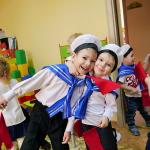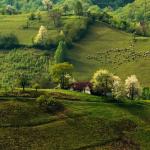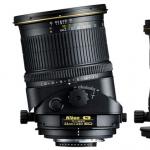Wintering birds. Internet lesson on the world around "wintering birds" Birds that fly to us for the winter
In the cold season, many birds fly away for wintering to warmer climes. However, there are those who do not leave their native places.

We will talk about them, as well as how to help them survive this hungry and cold time. Who, if not we, can lend a helping hand to living beings!
The body temperature of our birds reaches 41 degrees, so although they are gentle creatures, they always remain active in the cold. And only severe frosts and lack of food make most birds leave their homes, but not all. There are birds that manage to find food, and they don’t care about the cold, which is why they are called hibernating.
How is the wintering of birds and who stays with us?
SMALL, YES REMOTE.
Guessed? This is a sparrow.
sparrows
 sparrows
sparrows Since ancient times, these birds have been living side by side with humans, and have managed to adapt to the most difficult conditions of existence. They were even given a nickname - house sparrows.
They have long understood that you need to be closer to a person, then you will not be lost! It is not for nothing that people say about the sparrow: "Small, but daring", will not give offense and will not die of hunger - all day and is busy looking for food. And if he finds something to eat, he will call the whole family.
To keep warm, the gray bird spreads its feathers and becomes like a fluffy ball. You've probably heard the saying - puffed up like a sparrow. But not only her warm fluff coat saves the bird from frost and icy wind, but also universal mutual assistance: at night the birds gather in flocks and warm each other.
And so the wintering of birds passes, day by day approaching the long-awaited spring.
BEAUTIFUL GOLDFIN.
The whole winter in our parks and squares you can watch the handsome goldfinches.
Goldfinch
 Goldfinch
Goldfinch They really have a festive outfit: a red mask near the beak and neck, and bright yellow stripes on black wings. A real fashionista is a dandy-dandy. It is for such a beautiful outfit that the bird got its name.
Goldfinches get food for themselves in the forest, where they find birch catkins, alder cones, burdock or thistle seeds.
FORTY-THIEF.
These birds are not afraid of winter.
Magpie
 Magpie
Magpie They will always find food at any time of the year. These birds are dexterous, but skillful and, moreover, omnivores. Magpies do not immediately eat their finds, but they can bury the remains in the ground or hide in the nest. Just don’t think that these white-breasted birds only chirp and steal everything that glitters. Magpies are useful and necessary birds, they save our trees from beetles.
SIZARI.
An integral part of the city are pigeons, because they are always with us.
Pigeon
 Pigeon
Pigeon It turns out that in ancient times, pigeons lived in the mountains, which is why they now settle higher, in the attics of high-rise buildings. For dark gray feathers with a bluish tint, city pigeons are called "Sizari".
At the end of January, pigeons are already beginning to coo with their girlfriends and start mating dances.
FOREST BIRDS.
Life is also in full swing in the winter forest, it is always full of sounds: somewhere a woodpecker is knocking, somewhere siskins and jays are calling. Capercaillie, black grouse, and yellow-breasted titmouse remain for the winter.
Tit
 Tit
Tit Hardworking titmouse at any time of the year rummage through every crack in the trees in search of their favorite delicacy - harmful insects. It is the titmouse that is one of the first to report the approach of spring - its song can be heard in February.
In severe cold, they move closer to humans, and so the wintering of birds takes place at this time of the year.
NORTHERN GUESTS.
Crossbills, bullfinches, and tap dances come to us from far northern latitudes for wintering.
Bullfinches
 Bullfinches
Bullfinches Where they come from, in winter there is such a cold that the climate of the middle zone will seem like a resort.
Surprisingly, it is crossbills that make nests in winter and hatch babies!
And in conclusion, I would like to remind you that everything in nature is interconnected, that we all come from planet Earth, and we should try to help each other in difficult times.
The simplest feeder
 The simplest feeder
The simplest feeder
Many people do not stand aside, they feed our feathered helpers somewhere with bread, where with a grain, they make protozoa, because we all came into this world to live!
And you can see how we "caught" birds, but we didn't catch anyone and never will.
- December 2, 2013 Currently, you can observe a real boom, a new surge in fashion ...
Who flies to us to spend the winter from the North?
With the first frosts and snow, guests from the north come to us. Even from the islands of the Arctic Ocean itself, a small white bunting bird flies. Only the tips of the wings and the strip along the tail are black. For its resemblance to white snow and arrival with the first frosts, it is sometimes incorrectly called a bullfinch. Bunting loves to run along the roads - to look for food. No wonder it is also called snow plantain.
A real bullfinch with a bright red chest, in a black hat, with a black tail and wings. Remarkable bird.
He likes to feed on viburnum and rowan berries.
Not inferior in beauty to the plumage of the bullfinch and another northern guest - the waxwing. Feathers on the body are pinkish-gray, at the end of the black tail there is a wide yellow stripe, across the wing there are red droplets, on the neck there is a black scarf, and on the head there is a large sharply combed crest. The waxwing loves rowan berries - it can eat more of them in a day than it weighs!
 Another winter guest is the crossbill. Flocks of red-brown large-headed birds can be seen on coniferous trees, where there are more cones. Cone seeds are the main food of crossbills. It is not so easy to get a seed from a closed cone. Many would be happy to eat, but it doesn’t work out. The crossbill for processing cones has a special
Another winter guest is the crossbill. Flocks of red-brown large-headed birds can be seen on coniferous trees, where there are more cones. Cone seeds are the main food of crossbills. It is not so easy to get a seed from a closed cone. Many would be happy to eat, but it doesn’t work out. The crossbill for processing cones has a special
the instrument is his beak. A thick, strong, laterally flattened beak at the end is curved so that the upper and lower jaws intersect. With such a beak-cross, the crossbill easily pushes the scales of the cones and takes out the seeds. Disheveled, soaked cones are thrown to the ground. But since crossbills eat a small part of the seeds, the seeds remaining in the cone become the property of other birds and then squirrels. Cones processed and discarded by the crossbill can be recognized by the green needles, as the crossbill tears off the cone with part of the branch and needles.
The crossbill is the only bird that builds nests and breeds chicks in the midst of winter - in January! Strictly speaking, crossbills breed chicks all year round. But for us it is surprising and strange that the female crossbill incubates her eggs in a nest covered with snow. Miracles, and more!
Goals:
Learn attentively, listen, observe; understand and answer questions; encourage to imitate the voices of birds; enrich and activate the vocabulary on the topic; to cultivate a caring attitude towards birds in winter.
Equipment:
Interactive whiteboard, two feeders, presentation.
Preliminary work:
Reading fiction, bird watching, outdoor games, finger games, looking at an album "Birds" .
Course progress.
(Birds sing, children enter the group.)
Educator: Children, listen, who sings so sadly?
Educator: That's right, birds. Look out the window, they flew to us and want to sit and warm up, let's let them in.
(Children sit on chairs)
Educator: guys, why are the birds frozen?
Children: Because it's cold.
Teacher: Why is it cold?
Educator: guys, and you know, birds that live with us in the winter have flown to our window. They came to warm up, let's get to know them.
(An image of birds appears on the interactive whiteboard)
Educator: Children, look who flew to us?
Children: birds.
Educator: how many birds flew in?
Children: a lot.
Educator: Kids, who knows what kind of bird this is? This is a crow. She is big, black and screams: "kar-kar" Who is it?
Children: crow.
Educator: what crow?
Children: Big and black.
Educator: how does a crow scream?
Children: "kar-kar" .
Educator: That's right, guys, this is a crow, it is big, black and screams: "kar-kar" .
Educator: look guys, at this beautiful one. bright bird, do you know what it's called? this is a snowman. He has a red chest. What is the name of this bird?
Children: bullfinch.
Educator: what kind of breast does the bullfinch have?
Children: Red.
Educator: That's right, it's a bullfinch. What is this bird's name again?
Educator: guys, and here is another beautiful bird that flew to us, who knows what it's called? this is a titmouse. Look at her yellow breast, and on her head a blue cap. Children, who flew to us?
Children: titmouse.
Educator: what kind of breast does the titmouse have?
Children: Yellow.
Educator: And what color is the bullfinch's cap?
Children: Blue.
Teacher: Yes guys. This is a titmouse, she has a yellow breast, and a blue cap on her head. What is her name?
Educator: and you often met this little bird, who is it?
Children: (together with the teacher) sparrow.
Educator: how does a sparrow chirp?
Children: "chik-chirik" .
(Children get up and go to the rug)
Educator: Kids, let's get up and go to the mat, I'll turn on the magic music and let's turn into birds.
(Includes teacher music)
Fizkultminutka.
Oh, the birds flew, the little birds. 2 circles (Run on toes in a circle
Everyone flew, everyone flew, flapped their wings. 2 circles wave your hands)
They sat down on the path, ate grains. (We squat down and fingers
Key, key, key, key, how I love grains. 2 times peck grains)
We clean the feathers so that they are cleaner. (Alternately imitate with hands
Like this, like this, to be cleaner. cleaning feathers) 4 times
We jump on the branches to become stronger for the children. (Jumping in place) 6 times
Educator: Children, our breathing is not in order, we need to calm him down, we will turn into a crow (raise your hands while inhaling, lower your hands as you exhale, we say "Kar" .)
Calm your breath
They go, sit down, the teacher says mysteriously on the chairs, “Oh guys, what did I see !!
Educator: Oh, guys, what does it weigh on a branch there?
Children: feeder
Educator: And what is the feeder for? And for whom?
Children: For birds.
Educator: That’s right, it’s difficult for birds to find food in winter, so people help the birds feed them and make feeders, the children of the older group made a feeder, hung it on a tree and poured grains into the feeder.
Educator: And I made this feeder, we will go for a walk, hang it on a tree and fill it with food. And you will also make feeders at home with your parents, since there are a lot of birds and they all want to eat.
Different, beautiful birds fly to the feeder from all sides to peck at the grains.
Let's remember what kind of birds we will eat in the feeder in winter?
There was a large black crow, and a small gray sparrow, and a yellow-breasted titmouse, and a red-breasted bullfinch.
Kids, today we helped the birds, they got warm, we made a feeder for them, listen to how good they are and they sang their funny songs.
What birds winter in Ukraine? Which ones stay to winter, and which ones arrive, you can read all this information in the next article.
What birds winter in our area?
Here are the birds wintering in Ukraine: bullfinch, titmouse, woodpecker, sparrow, jay, hawk, dove, crow, magpie, etc.
The main goal of all birds in winter is to find food and survive the winter, severe frosts and cold. Many of the birds are migratory species, they seek salvation in "warm places". The northern regions of Ukraine are "warm regions" for some birds
What birds come to us for the winter?
Birds arriving to winter in Ukraine:
yellow-headed beetle
Breeds in Polissya, Carpathians and Crimean Mountains. In winter it roams all over Ukraine. Appears quite early, common in coniferous forests.
Where to look: forests, parks. Usually kept in the crowns of trees. Easily recognizable by voice.
When: October - April
Bullfinch
Breeds in Polissya, Carpathians. In winter, they are found throughout the territory. They keep in flocks. They feed on mountain ash, ash lionfish, peck buds in spring.
Where to look: forest edges, parks. Easy to recognize by voice.
When: October-April
Regular tap dance
Often fly in large flocks, but not every year. Separate individuals are found together with chizhama, linnet.
Where to look: fields overgrown with weeds.
When November-March.
gray shrike
Nesting in the north of Ukraine. In winter, they are found throughout the territory. They keep alone in open spaces. Looking out for prey, they usually sit on the tops of bushes, low trees.
Where to look: fields, wastelands.
When: October-March.
mountain wagtail
Breeds in the Carpathians and Crimean Mountains. In winter, it can be found throughout Ukraine, where there is running non-freezing water. It is regularly observed in Dnepropetrovsk, Zaporozhye and Kyiv regions. Stay single.
Where to look: non-freezing flowing reservoirs (streams, canals, drains).
When: December - April
So, we hope that you have found the answer to the question “which birds stay for the winter”, and have learned something new for yourself.
"The external structure of birds" - Rod. Head. Language. With a magnification of 10 times, you can see the barbs of the first order. How are reptiles similar to birds in appearance? Contour flywheel. The external structure of the bird. Fan. Mandible and nostril. Where are the largest feathers located, and where are the smaller ones? And why does the bird have such beautiful outfits?
"Biology class of birds" - Crying in the swamp. Isn't it scary to live there? Nelmachevskaya basic comprehensive school. Birds of reservoirs and coasts. Night birds of prey. He sleeps during the day, flies at night, and frightens passers-by. Timofeeva Nina Nikolaevna teacher of biology and chemistry. Walks waddle, Stumble. Birds of the forest. The cerebellum in birds is poorly developed.
"The internal structure of birds" - Reproduction and development of birds. Nervous system. Origin of birds. Air. Pen structure. Types of chicks. Nesting. Bird habitats and modes of movement. Circulatory system. The ducts from the testes flow into the cloaca. Brooding. Journey into the world of birds. - Build nests. Digestive system.
"The development of birds" - The development of the egg. "Drumroll. They fly away for wintering outside the nesting range to "warm" regions. Nomads. Bullfinch, waxwing, rook. Promotes physiological maturity. Capercaillie. Dive. Built in India in 2010. Sexual dimorphism in birds. Crane. Post-nesting migrations. Ovary. Stages of development of the embryo of a bird.
"The structure of the bird" - The tail of birds is greatly shortened and performs a steering function. Pen structure. The jaws are devoid of teeth and form a beak. All bones of the skull, with the exception of the lower jaw, are fused. "Features of the structure and life of birds as highly organized vertebrates". What advantages do birds have by spending most of their lives in flight?
"Bird Facts" - The evolution of birds. Sexual system. Bird class. Digestive system. Variety of birds. Birds in human life. Circulatory system. Importance of birds in nature. Nervous system. Interesting Facts. excretory system. Bird eggs. External building. A little about birds.
In total there are 28 presentations in the topic





